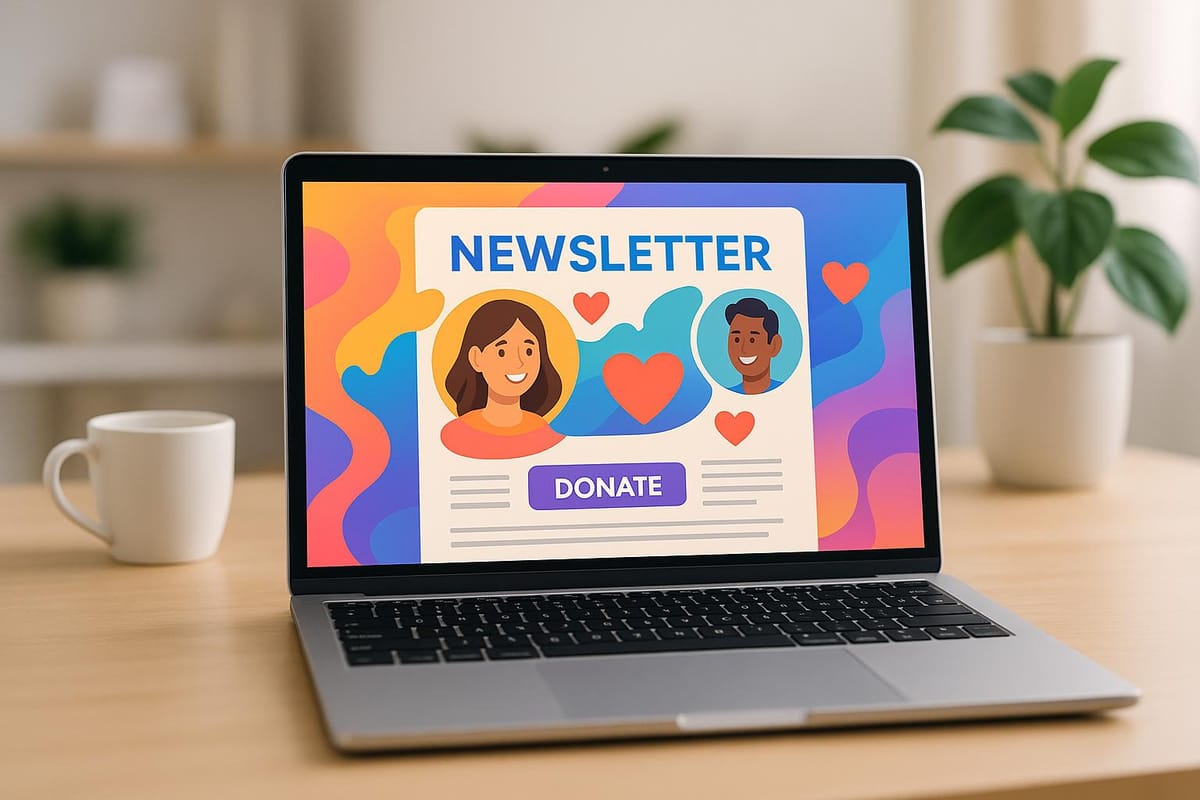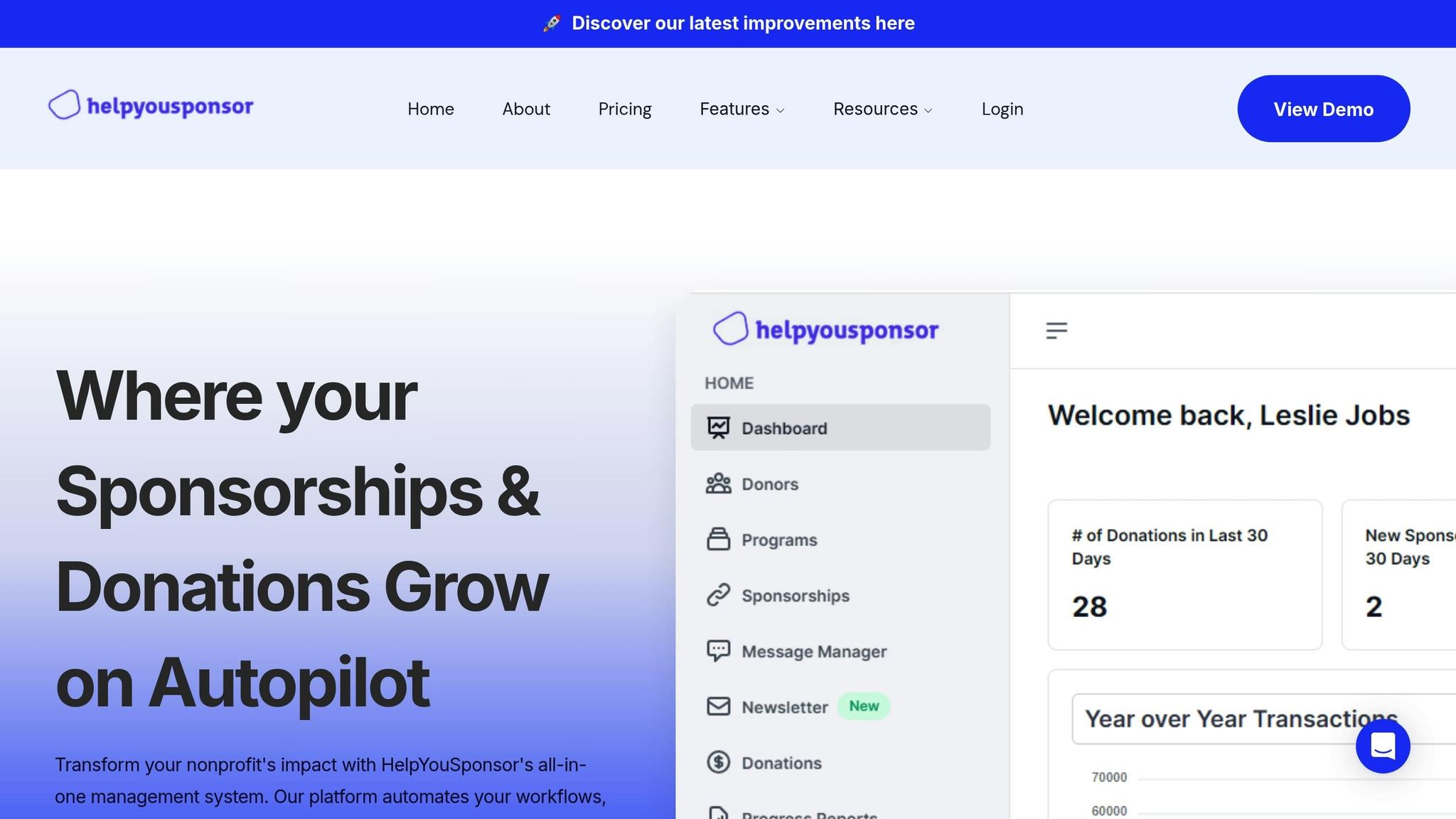How Newsletters Boost Donor Retention
Explore how newsletters enhance donor retention by fostering engagement, trust, and emotional connections with supporters.

Newsletters are one of the simplest ways to keep donors engaged and increase retention rates. Here’s why they work:
- Retention Rates Are Low: Only 39% of donors stick around, and over half of first-time donors never give again.
- Engagement Drives Loyalty: Regular updates make donors feel connected, increasing retention to 60% after a second gift.
- Proven Impact: Organizations using newsletters see retention rates rise from 40-45% to 53%. Personalized emails with updates and stories build trust and emotional connections.
Research Data: How Engagement Affects Donor Loyalty
When it comes to tackling donor retention challenges, research leaves no doubt: regular engagement is a game-changer. The link between keeping donors engaged and improving retention isn’t just a theory - it’s backed by solid numbers. Studies show that organizations prioritizing consistent communication with their donors see noticeable improvements in both loyalty and revenue. Let’s dive into the data that highlights just how impactful donor engagement can be.
Main Research Results on Donor Engagement
The numbers speak for themselves: regular communication can boost revenue by 41.5%. Specifically, online donor communication drives that same 41.5% revenue growth, while maintaining email contact with offline donors increases retention rates by 29%. Email proves to be a powerful tool, with 33% of donors saying it inspires them to give, and 48% preferring it for updates and appeals.
Engaged vs. Unengaged Donors
The difference between engaged and unengaged donors is striking. Donors who receive regular updates, such as newsletters, show far greater loyalty. Recurring donors, for example, are retained at nearly double the rate of one-time donors - 83% compared to 45%. And the benefits don’t stop there: recurring monthly donors have 5.4 times the lifetime value of single-gift donors.
Breaking it down further, retention rates grow with donation frequency. One-time donors have a retention rate of 32.1%, but this jumps to 53.0% for two-time donors, 70.7% for those giving three to six times, and an impressive 86.8% for donors who give seven or more times. Gift size also matters - donors giving less than $100 are retained at a rate of 53%, while those contributing $250 or more see a retention rate of 76%.
Numbers That Show Newsletter Results
Case studies highlight the effectiveness of newsletters in driving engagement. One healthcare organization, for instance, trimmed its supporter newsletter from 12 pages to just 4, making it more engaging while cutting costs. The result? Higher engagement and a ~30% revenue increase. By using the savings to distribute 25% more newsletters, they achieved these gains without increasing their budget.
Personalized newsletters also deliver measurable results. Emails with personalized subject lines see a 26% higher open rate, and personalized calls-to-action boost conversions by an astounding 202%. Adding visual elements like videos further enhances engagement, with click-through rates increasing by 65%.
Email marketing continues to be a cornerstone strategy for nonprofits, with 86% of organizations using email and 45% sending newsletters monthly. Even small improvements in retention can have a big impact - a mere 10% increase in donor retention can double the lifetime value of a donor base. This makes newsletters one of the most cost-effective ways to build lasting donor relationships.
How Newsletters Keep More Donors
Personalization plays a powerful role in keeping donors engaged. When messages are crafted to feel personal, they can turn one-time contributors into loyal, long-term supporters. Why? Because personalized communication makes donors feel appreciated and connected to the cause they care about. Let’s explore how newsletters can strengthen these relationships.
Building Emotional Bonds
Personal Messages That Highlight Donor Impact
When you tailor your messages to reflect a donor's unique contribution history, it shows you notice and value their support. For example, referencing a specific donation and explaining how it made a difference not only reinforces their decision to give but also builds a stronger emotional connection. This thoughtful, individualized approach can inspire continued involvement.
Regular Updates That Build Trust
Keeping donors informed about the ongoing impact of their contributions is essential. Newsletters that share meaningful updates, success stories, or progress reports show transparency and accountability. This consistent communication helps establish trust, making donors more likely to stay committed over time.
Measuring Newsletter Effects on Retention
Organizations that incorporate newsletters into their strategies often experience noticeable improvements in donor retention rates. The data consistently highlights how newsletters can strengthen donor loyalty and enhance program outcomes.
Retention Rates Before and After Newsletters
The numbers tell a compelling story. For most organizations, donor retention rates typically fall between 40% and 45%. However, nonprofits that prioritize a digital-first approach - especially by using newsletters - see retention rates climb to an average of 53%.
The benefits are even more pronounced when organizations collect email addresses from their "offline-only" donors. Just adding an email address to the mix can increase these donors' annual value and retention rates by a staggering 73%. This simple step shifts the donor relationship from occasional interaction to consistent engagement.
| Metric | Without Newsletter Strategy | With Newsletter Strategy | Improvement |
|---|---|---|---|
| Overall Retention Rate | 40–45% | 53% | +8–13% |
| Offline Donor Annual Value | Baseline | +73% increase | 73% boost |
| Offline Donor Retention | Baseline | +73% increase | 73% boost |
| First-Year Retention (48-hour follow-up) | 15% | 25–40% | +10–25% |
A focused approach to email communication also pays off. In one study, sending weekly cultivation emails led to a 21% increase in revenue from existing donors and a 14% boost from lapsed donors. Similarly, organizations that implement a 48-hour follow-up after a donor’s first gift see first-year retention rates rise from 15% to as high as 40%.
These improvements don’t just stop at retention - they also foster greater satisfaction among donors and amplify the impact of the organization’s programs.
Effects on Donor Satisfaction and Program Results
Newsletters do more than keep donors engaged - they also enhance satisfaction and drive better program outcomes. For example, personalized emails can increase click-through rates by 83% and donations by 29%. Even small touches, like addressing donors by name (e.g., "Hi, Jeff"), can lead to a 270% boost in clicks.
The content of newsletters matters, too. When donors were encouraged to engage with just one article per email, donations increased by 27%. Recurring donors, who are often nurtured through consistent communication, contribute 42% more annually, generate 42% higher returns on events, and give 440% more overall compared to one-time donors.
Recognizing donors personally can further enhance their satisfaction. Take UNICEF, for instance. When they split their donor file into two groups - one receiving thank-you calls and the other receiving both thank-you and birthday calls - the latter group showed a 25% increase in engagement.
Digital tools like newsletters also enable organizations to provide timely updates and foster deeper connections. For example, World Vision uses video calls and online platforms to connect sponsors with the children they support, creating a more meaningful and engaging experience.
These measurable gains in retention and satisfaction highlight the transformative role newsletters play in building lasting donor relationships. By bridging the gap between one-time donations and long-term partnerships, newsletters lay the groundwork for sustainable growth and stronger donor ties.
Best Methods for Creating Effective Newsletters
Effective newsletters are key to building strong, lasting relationships with donors. By focusing on meaningful engagement, these strategies address common retention challenges and help deepen connections with supporters.
Content That Resonates with Donors
Crafting content that truly connects with donors means going beyond statistics and focusing on stories that highlight real impact. Use compelling narratives and examples of beneficiaries - complete with photos and quotes - to show the difference donors are making. For instance, instead of saying, "Our education program served 200 children this quarter", you could write, "Maria, age 8, can now read her favorite bedtime story to her little brother thanks to the literacy program your support made possible." This kind of storytelling creates an emotional connection and inspires action.
Incorporate donor spotlights to recognize their contributions and motivate continued support. Keep your content varied but intentional - share behind-the-scenes updates, upcoming events, and clear calls to action that encourage donors to get involved in ways beyond financial giving. The goal is to inform, inspire, and engage, not just to ask for donations.
Finding the Right Frequency and Timing
Most nonprofits send about three email newsletters and two fundraising appeals each month. As a starting point, consider sending a monthly newsletter and track its performance closely.
Expert Erica Waasdorp suggests sending at least one email newsletter and one fundraising appeal per month, while experimenting with different frequencies to see what works best. Use A/B testing to evaluate send times and measure key metrics like open rates, click-through rates, unsubscribe rates, and delivery rates. Offering donors the option to customize their communication preferences can also enhance engagement - some may prefer weekly updates, while others might only want quarterly summaries.
Above all, prioritize quality over quantity. A single, well-thought-out newsletter can have a far greater impact than multiple lackluster ones. These timing strategies set the foundation for using tools like HelpYouSponsor to further refine your approach.
How HelpYouSponsor Enhances Newsletter Strategies

HelpYouSponsor takes your newsletter game to the next level by combining automation with donor insights. The platform simplifies newsletter creation by pulling together donor data, automating messaging, and providing in-depth performance analytics.
With its donation tracking feature, you can segment donors based on their giving history, sponsorship involvement, and engagement levels, allowing for highly personalized content. Automated messaging ensures consistent communication without losing the personal touch that keeps donors engaged.
HelpYouSponsor also offers detailed analytics to help you understand what resonates most with your audience. Metrics like open rates, click-through rates, and donation activity provide valuable insights for refining your content strategy.
For nonprofits managing multiple sponsorship programs, HelpYouSponsor's versatile tools make it easy to tailor newsletters to different donor groups. Its intuitive interface allows staff to create professional, polished newsletters without needing technical expertise. Plus, integrated payment gateways enable donors to contribute directly through newsletter calls to action, making the giving process seamless and efficient.
Conclusion: Newsletters as a Foundation of Donor Retention
Newsletters are a powerful tool for keeping donors engaged and committed to your cause. With email delivering an impressive return of up to $36 for every $1 spent, they stand out as one of the most cost-efficient ways to maintain donor relationships and encourage repeat giving.
Trust plays a key role in donor support. While 67% of donors say trust is essential before making a gift, only 22% report high trust in charities. This gap offers nonprofits a chance to strengthen relationships by providing transparent updates. Regularly sharing how your organization is making an impact can help close this trust gap and build lasting donor confidence.
Beyond trust, newsletters create emotional connections that inspire continued support. Research highlights that donors who feel emotionally invested and satisfied with their giving experience are far more likely to donate again. By including impact stories, celebrating donor contributions, and showing exactly how donations are used, newsletters foster the kind of connection that turns one-time donors into lifelong supporters.
To make newsletters truly effective, focus on creating content that resonates with donors. Share meaningful accomplishments, highlight the real-world impact of donations, and ensure transparency about fund usage. Segmenting your audience for personalized communication and tracking engagement metrics can further refine your strategy. These tactics lay the groundwork for maximizing your newsletter's potential.
For nonprofits looking to take their newsletters to the next level, platforms like HelpYouSponsor offer tools to streamline the process. With features like donor segmentation, automated messaging, and detailed analytics, HelpYouSponsor makes it easier to craft professional, personalized newsletters that strengthen donor loyalty. Combining these tools with proven strategies can help nonprofits unlock the full potential of newsletters, driving both donor retention and organizational growth.
FAQs
How do personalized newsletters help retain donors and strengthen their engagement?
The Power of Personalized Newsletters in Donor Retention
Personalized newsletters are an effective way to strengthen relationships with donors, creating a sense of connection that goes beyond simple transactions. By crafting content that reflects each donor’s interests, previous contributions, and their unique connection to your cause, you’re showing them they matter. This thoughtful approach builds trust and fosters loyalty over time.
Studies reveal that when communication feels personal, donors are more likely to stick around. It not only improves retention rates but also encourages bigger contributions and ongoing involvement. Swapping out generic updates for content that resonates on a personal level helps forge a deeper bond, motivating donors to remain dedicated to your mission.
What are the best ways to create newsletters that keep donors engaged and inspired?
To craft newsletters that genuinely resonate with donors, keep the focus on clear and concise messaging. Highlight the real-world impact of their contributions by sharing success stories, updates on programs, and examples of how their support is driving change. Make it personal - address donors by name and, when possible, align the content with their specific interests.
Sticking to a regular schedule is just as important. Consistency helps maintain engagement and builds trust over time. Use a warm, conversational tone, and always center the narrative around the donor's role in your mission. By showcasing the meaningful results of their generosity, you can deepen their connection to your cause and encourage lasting support.
How can nonprofits evaluate the effectiveness of newsletters in retaining and satisfying donors?
Nonprofits can measure how effective their newsletters are by keeping an eye on a few key metrics. For instance, donor retention rates - the percentage of donors who continue their support year after year - offer a clear picture of long-term engagement. Similarly, tracking email open rates and click-through rates helps gauge how compelling the content is and whether it’s prompting readers to take action.
For a more in-depth understanding, nonprofits might consider conducting donor satisfaction surveys. These surveys can reveal how newsletters are impacting relationships with supporters. By analyzing these data points together, organizations can pinpoint what resonates most with their audience and adjust their messaging to strengthen connections and achieve better outcomes.

